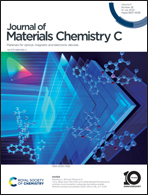A reversible gel-free electrode for continuous noninvasive electrophysiological signal monitoring†
Abstract
Continuous and accurate acquisition of electrophysiological signals is critical in health monitoring and disease diagnosis. However, degradation of electrophysiological electrodes can occur during long-term and continuous monitoring, leading to poor signal quality. Herein, we report a reversible and continuously monitored gel-free sponge electrode, which was prepared by vacuuming melamine resin sponge (MS) and an aqueous solution consisting of poly(3,4-ethylenedioxythiophene):polystyrene sulfonate (PEDOT:PSS), poly(vinyl alcohol) (PVA), and ethylene glycol (EG). The electrode exhibits a low contact impedance of 3.5 kΩ and excellent mechanical stability with 10 000 cycles of compression. Additionally, the electrode possesses a long shelf life and the ability to recover its initial electrical performance. Therefore, they enable continuous surface electromyography (sEMG) signal monitoring for 8 hours and have an excellent durability of up to 6 months. The signal-to-noise ratio (SNR) of this gel-free sponge electrode (9.82 dB) is higher than that of the commercial gel electrode (7.92 dB). Finally, we verified that these achieved dry or semi-dry electrodes can accurately detect biopotential signals, including electrocardiogram (ECG), electroencephalogram (EEG), and electrooculogram (EOG). This study provides a pathway to design a reversible, long-lasting, high-quality gel-free electrode for electrophysiological signal monitoring.



 Please wait while we load your content...
Please wait while we load your content...